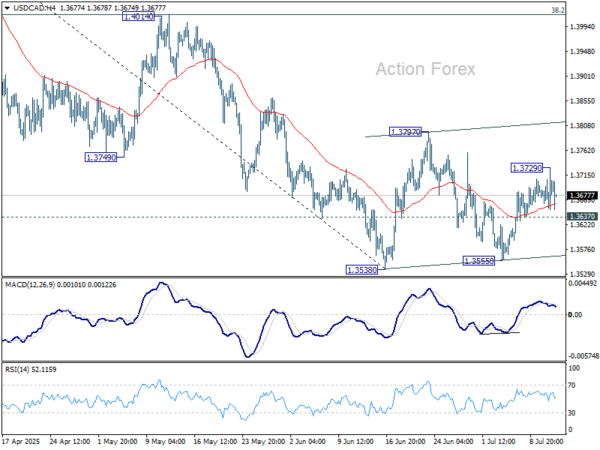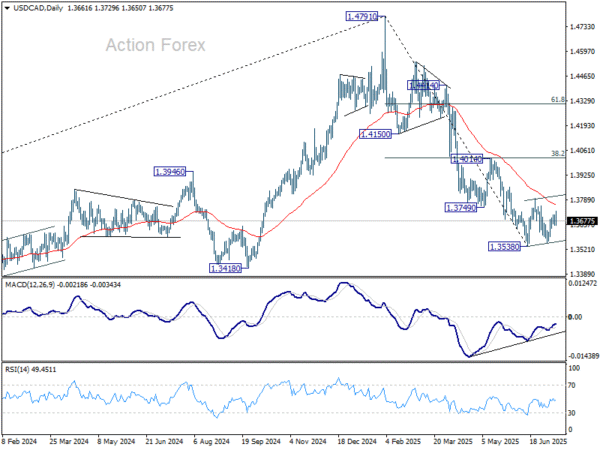Loonie Rebounds on Strong Jobs Data, Sterling Hit by GDP Miss – Action Forex
Canadian Dollar staged an impressive rebound after June’s employment report far outpaced expectations, reviving hopes that BoC can stay on hold despite mounting trade pressures. The release comes just after US President Donald Trump announced sweeping 35% tariffs on Canadian imports, which initially drove the Loonie lower.
With interest rates sitting at 2.75%—a level seen as largely neutral, today’s’s data gives BoC additional justification to delay any further policy action. Policymakers are likely to wait and evaluate the full effects of the tariffs before committing to the next move.
Meanwhile, in the UK, recession risks are rising after GDP contracted for a second straight month. The economic miss raises doubts about BoE’s current path of gradual, quarterly rate cuts. Market pricing now reflects over 75% odds of a 25-basis-point BoE cut in August. BoE had projected 0.25% GDP growth in Q2, but unless June’s GDP rebounds sharply, a quarterly contraction is now a real possibility.
On the FX front, Aussie remains the top performer of the week. while Dollar and Swiss Franc are next in line. Yen is stuck at the bottom, with Pound and Euro also under pressure. Loonie’s rebound keeps it in the middle, alongside Kiwi
As the week winds down, risk appetite appears to be cooling. US and European equities had powered ahead earlier, but signs of fatigue are emerging. Traders are lightening positions ahead of the weekend, especially as the European Union may be next in line to receive Trump’s tariff demands.
In Europe, at the time of writing, FTSE is down -0.56%. DAX is down -1.01%. CAC is down -1.09%. UK 10-year yield is up 0.005 at 4.606. Germany 10-year yield is up 0.008 at 2.713. Earlier in Asia, Nikkei fell -0.19%. Hong Kong HSI rose 0.46%. China Shanghai SSE rose 0.01%. Singapore Strait Times rose 0.30%. Japan 10-year JGB yield rose 0.009 to 1.506.
Canada job growth surges to 83k in June, unemployment rate unexpectedly falls
Canada’s labor market posted a strong rebound in June, adding 83,000 jobs, far above expectations of just 900. Unemployment rate dipped from 7.0% to 6.9%, defying forecasts of an increase to 7.1%.
The decline ends a three-month stretch of rising joblessness and was supported by a 0.1 percentage point uptick in the employment rate to 60.9%. Total hours worked also rose by 0.5% on the month, putting them 1.6% higher than a year earlier—a sign of sustained underlying momentum.
Wage growth continued to moderate, with average hourly earnings rising 3.2% yoy from a year ago, down from May’s 3.4% yoy.
ECB’s Schnabel: Inflation on track, economy resilient, bar for further rate cut very high
ECB Executive Board member Isabel Schnabel signaled in an interview with Econostream Media that there is urgency for further easing. Schnabel noted that inflation is now projected to be at 2% target over the medium term, and expectations remain “well anchored”, while interest rates are in a “good place”. She added that “the bar for another rate cut is very high”.
Schnabel emphasized that there is “no risk of a sustained undershooting” and that core inflation is forecast to meet target throughout the horizon. She also downplayed concerns over the disinflationary impact of Euro strength, calling such fears “exaggerated” given limited pass-through effects. Schnabel argued that temporary factors such as low energy inflation are unlikely to derail the ECB’s price stability goals.
On the growth front, Schnabel was notably upbeat. Recent PMI data suggesting further recovery ahead. Manufacturing indicators such as new orders and export demand have all reached three-year highs, pointing to more than just temporary momentum. Combined with record-low unemployment and the expectation of a large fiscal impulse, she argued that risks to the growth outlook are now “more balanced”, reducing the case for near-term rate action.
UK GDP shrinks -0.1% mom in May, but underlying momentum still holds
UK GDP unexpectedly contracted by -0.1% mom in May, missing expectations for 0.1% mom growth. The weakness was driven by a sharp -0.9% mom drop in industrial production and a -0.6% mom fall in construction output, partially offset by a modest 0.1% mom gain in services—the largest sector of the economy.
Still, broader momentum remains positive. Real GDP rose 0.5% in the three months to May, thanks to steady growth in services (+0.4%) and solid gains in construction (+1.2%). Production also rose 0.2%.
New Zealand BNZ manufacturing rises to 48.8, conditions still very tough
New Zealand’s manufacturing sector showed modest signs of stabilization in June, with the BusinessNZ Performance of Manufacturing Index rising from 47.4 to 48.8. While still signaling contraction, the gain was underpinned by an encouraging rebound in new orders, which jumped from 45.4 to 51.2—breaking back into expansion. Employment (47.9) and production (48.6) also improved slightly, though both remained under the 50 threshold. The headline PMI remains well below the historical average of 52.5.
The proportion of negative comments from respondents held steady at 65.5% (May 64.5), with widespread concerns over weak consumer demand, high living costs, and a murky economic outlook. Input cost pressures and a drop in construction activity also continue to weigh on manufacturing sentiment.
BNZ Senior Economist Doug Steel said that despite hopes of recovery, “conditions are still very tough.” All key sub-indices remain below their long-run averages, highlighting that while some green shoots are emerging, the overall manufacturing environment is still struggling to gain traction.
USD/CAD Mid-Day Outlook
Daily Pivots: (S1) 1.3636; (P) 1.3666; (R1) 1.3692; More…
USD/CAD retreated after a brief spike to 1.3729 and intraday bias is turned neutral again. Overall, consolidation pattern from 1.3538 could still extend. Above 1.3729 will target 1.3797 resistance and possibly above. On the downside, however, break of 1.3637 minor support will bring retest of 1.3538/55 support zone instead.
In the bigger picture, price actions from 1.4791 medium term top could either be a correction to rise from 1.2005 (2021 low), or trend reversal. In either case, further decline is expected as long as 1.4014 resistance holds. Next target is 61.8% retracement of 1.2005 (2021 low) to 1.4791 at 1.3069.


